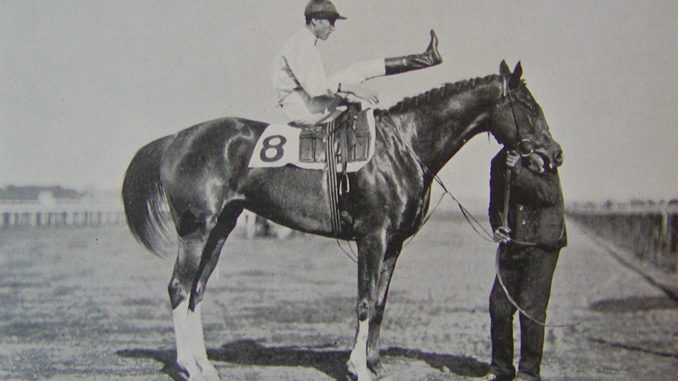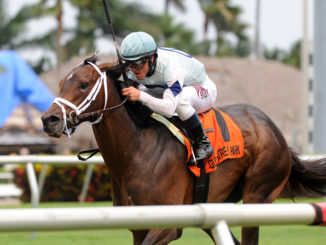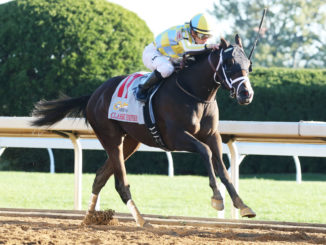
by TERESA GENARO
Seventeen years ago, City Zip accomplished the impressive feat of sweeping Saratoga’s major stakes for two-year-olds on dirt, the Sanford, the Saratoga Special, and the Hopeful. Ninety-six years before that, a two-year-old named Tanya accomplished something that might be even more impressive, and as unlikely to recur as City Zip’s sweep.
Now, Saratoga bookends its meet with weekends of two-year-old stakes races: the Schuylerville and Sanford, for fillies and colts respectively, on opening weekend, and on this closing weekend, the traditional Spinaway and Hopeful, run two days apart. It’s rare to see a filly entered to run against colts, but back in 1904, neither of these was true, and thus enters Tanya.
But before her, Spinaway.
Born in 1878, the chestnut filly reportedly raced nine times and won seven races, finishing second in the other two. Her career ended in 1881 following an injury, and it was in that year that the race named for her debuted, won by Memento, who, like Spinaway at one time, was owned by George Lorillard.
Fourteen years later, Spinaway had a filly by Hanover; owned in part by Harry Payne Whitney, son of William Collins Whitney, the man who had rescued Saratoga at the turn of the 19th century, she was named Handspun, and she won the Kentucky Stakes and Willow Handicap at two, finishing second in the Matron. At three, she won the Tennessee Oaks.
In 1902, she, too, had a chestnut filly, this one with “white feet and a strip.” Named Tanya, the New Jersey-bred was bred by W.C. Whitney, who died in February of 1904, before the filly began racing. Whitney’s horses were leased to H. B. Duryea, in whose green and white colors she raced and won as a two-year-old.
Already dominant by the time she got to Saratoga, Tanya was a popular filly at the Spa, for both her speed and her pedigree, and her win in the Spinaway by a length and a half in its 15th renewal in 1904 elevated her to something of a racing superstar. She was a “great filly,” opined The Times, and her win “so one-sided that there practically was no betting on it.” The reporter went on,
The victory of Tanya appealed strongly to sentiment among the older turfmen, Tanya being the granddaughter of the great race mare for which the stake was named, Spinaway, the best filly of the memorable year in which Hindoo began his turf career.
“Tanya has,” wrote the New York Times, “proved herself worthy of her ancestry.”
And so she did, winning not only the Spinaway that year, but also, ten days later, the Hopeful. Carrying 127 pounds, she conceded weight to the 10 other horses in the field and won by a length and a half. She was of the same foal crop as the remarkable Sysonby, before the Hopeful considered the best two-year-old in training. But…
The best of the remarkable lot of fillies trained in the stable of H.B. Duryea…has caused horsemen to revise opinions formed when Sysonby of the James R. Keene stable was fresh from his triumph in the Saratoga Special. Even the enthusiasts among Sysonby’s admirers now are willing to admit that Tanya is the Keene colt’s most formidable rival.
Her race to-day was the most remarkable run by a filly in the memory of turfmen, and her success left not the least room for question that Tanya ranks with the best of her age and sex that the American turf has ever produced. (New York Times)
And that was before she won the Belmont Stakes in 1905, the second filly to do so, and the last until Rags to Riches—another chestnut filly–won in 2007.
As a two-year-old, Tanya won five of six races, and in October of 1904, after Tanya’s Saratoga triumphs, Duryea dispersed the stock he’d gotten from Whitney at an auction held at Madison Square Garden, an auction that reportedly drew 10,000 people (a New York Rangers sell-out is 18,200). Whitney’s son, Harry Payne Whitney, bought many of the horses, including Tanya for $7,000 and her dam Handspun for $22,000. The never-hyperbolic Times called the auction “the most remarkable horse sale ever held in America or probably in the world…”
So Tanya ran in the Belmont for her new owner, winning the first Belmont Stakes held at Belmont Park; she finished second the next month in the Lawrence Realization to the great Sysonby. Her Pedigree Query page says that Tanya made 12 starts, with a record of 6-2-1, and that she was sent to France in 1912, returning to the United States in 1918, after the end of World War I. She died in 1929, and in 1951, the Daily Racing Form recalled her as a “splendid racer who could carry her speed over a distance” and “one of the finest fillies ever bred” by William Collins Whitney. The same article referred to her second dam as “the famous Matriarch Spinaway.”
Tanya isn’t in the Hall of Fame, and she’s not a champion. But she was the first to win both the Spinaway and the Hopeful, something only one other horse, Bee Mac in 1943, has done, and in winning the Hopeful and the Belmont, she joins just 12 other horses in the 120-year history of the two races. The most recent horse to win the Hopeful-Belmont double was Afleet Alex in 2005; before that, it was Affirmed in 1978. Other notable winners of the two races: Man o’ War, Whirlaway, Native Dancer, and Secretariat.
Heady company, that, so much so that we must appreciate “most strongly,” like those 1904 older turfmen, Tanya’s victory in the Spinaway, the race named for her grandmother. Leon Rasmussen wrote in 1951 that Tanya “will long be remembered for what [she] accomplished on the race track.”
But not, alas, by a race honoring what she achieved.



